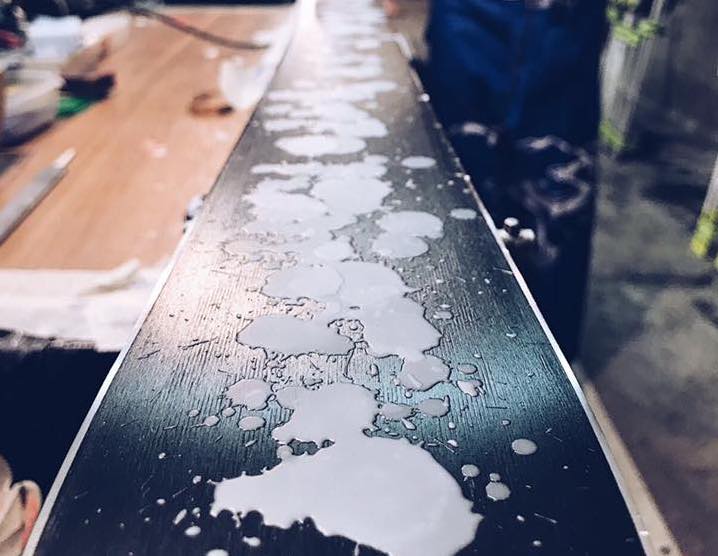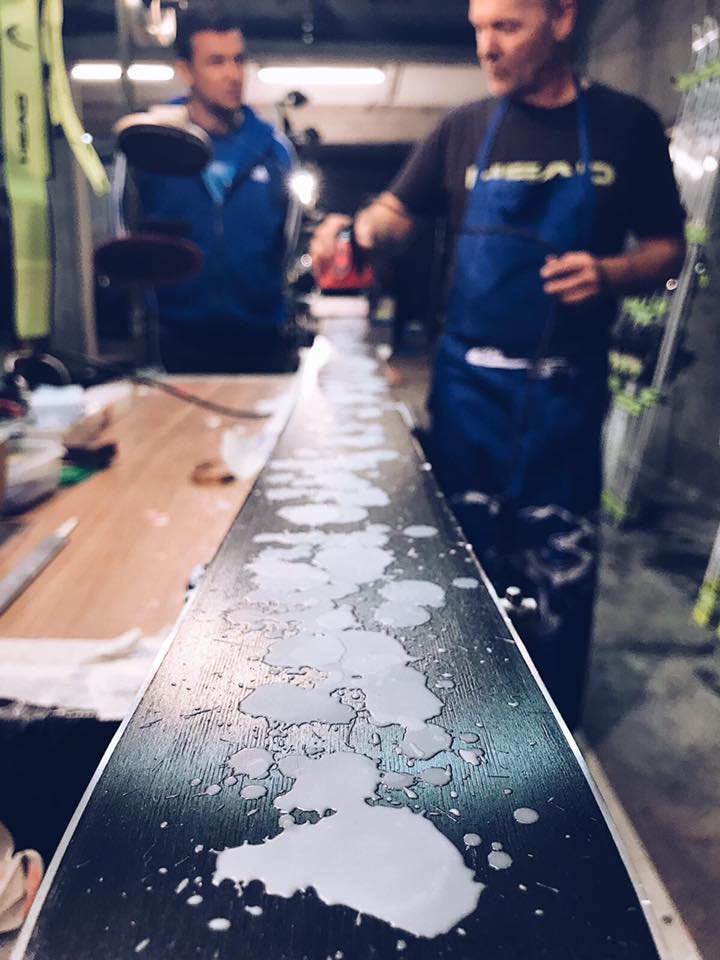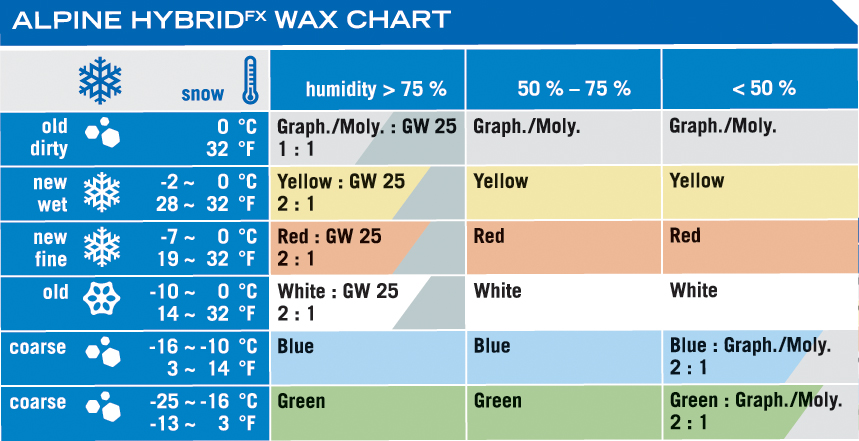Ski Servicing Guide: how to wax your own skis properly

Waxing your skis is critical to their performance and longevity. Andy Taylor takes us through how to do it properly
Words by Andy Taylor from Anything Technical. He recommends Holmenkol wax for ultimate performance.
With ski + binding packages averaging £460-£620 (and often more), looking after your equipment properly has never been so important. Even if you only ski a couple of weeks a year, it’s still essential to car for your kit correctly. You wouldn’t buy a car and not get it serviced and MOT’d, and you shouldn’t with skis either – poorly tuned skis are a sure-fire way to ruin your next trip to slopes.
For me, waxing the base of your skis or board is the most important element of servicing them. Get this wrong, and your next ski day will be miserable. If you’ve ever had your ski bases stick to the snow and refuse to glide freely then you know what I mean.
Waxing your skis should be done on a regular basis. Sadly, the general perception is that waxing is ‘highly technical’ and should only be carried out by experts, but that’s really not the case. Servicing your skis yourself is actually very therapeutic and enjoyable – especially with a ski film on in the background and a tin or two of good beer to help the process along.
How does waxing help ski performance?
If you ask a typical recreational skier what waxing does, their answer nearly always relates to increased speed – but waxing actually has far more benefits than just making you glide over the snow better:
- Waxing your bases regularly reduces how quickly they wear down, increasing the longevity of your skis
- The wax helps to nourish the polyethylene base and prevents it from drying out through natural oxidisation, like using a moisturiser on your skin
- The correct wax for the relevant snow/temperature conditions improves glide
- Waxing also makes it much easier to turn your skis by reducing friction/resistance, giving you more control and safer skiing
Within waxing, there are two main categories: cold/surface waxing (known as rub-on waxes) and hot waxing (waxes that are applied with a hot iron). Cold waxing is a quick way to stop your skis sticking while out on the slopes, as you can quickly apply it in the next gondola; however a proper hot wax will last longer and is what your skis really need to stay in tip top condition.
How to hot wax your skis yourself
Follow these simple steps to improve your ski performance, longevity and enjoyment:
HOW TO – Hot Wax your skis
A detailed video about how to wax your skis using hot wax. If you have any questions please feel free to ask us in the comments down below or contact us at info@skiequipmentuk.co.uk.
Decide which temperature ski wax to use
skiequipmentuk.co.uk/products/waxes-and-tools/?filter_brands=holmenkol(opens in a new tab)
First decide which wax to use. Ski waxes come in different temperature ratings – both for application and for use on snow. We recommend using Holmenkol waxes, but to decide which to use, you need to identify what the snow is like in your chosen ski destination.
Many people simply use a universal wax to cover a wide range of temperatures (generally around 0°C to -18°C), but if you want ultimate performance you have to be more specific and use the correctly rated wax.
To work out which wax to use you can look at current snow temperatures and future weather forecasts, but most importantly, you have to look into the past too. Compacted snow holds the core temperature for longer than most people realise, so for example if the current temperature is -4°C but the previous week was -12, a harder/colder temp wax may be more appropriate.
Prepare your skis for waxing
Next it’s time to prepare your skis so they properly hold and absorb the new wax.
- First remove any old wax or storage wax from the base with a plastic scraper. If you haven’t used your skis in a while, you might want to gently warm the wax with your iron to make it easier to remove, or use a wax remover.
- Heat your iron. Most hot waxes are temperature dependant, so ensure the iron is at the correct temperature for your chosen wax.
- Hold your chosen wax against the hot iron, and allow it to drip slowly off the face onto the ski base. If the wax is running off like a leaking tap, STOP! Turn the iron down, let it cool for a minute or two, then re-apply. Otherwise you can very easily burn the wax, rendering it useless.
- Rub the iron quickly up and down the base – make sure you keep it moving otherwise you can burn it.
- Working quickly before the wax has time to cool, use your plastic scraper to remove the wax. The wax should be quite soft still but not in a liquid/molten state. This will lift any dirt or other particles from the base.
- Use a waxing brush (either horse hair or synthetic) to brush the base from tip to tail in long stokes. This will lift any remaining wax from the base, preparing it for the next process.
Apply the wax for real
- Apply your chosen wax with a hot iron, using the same method as step 3 above.
- Run the iron up and down the base without stopping. Ideally you want to create a nice even finish, making sure all of the base is covered and penetrated.
- Put the iron on the workbench. Place your hand underneath the ski (on the top, which will be facing down). If the top sheet feels warm, the wax has sufficiently penetrated the pores of the base and do not need to re-apply. If not, carefully repeat step 2.
Finishing the ski waxing process
Follow up the waxing process for a smooth finish and optimum glide.
- Once you’ve applied the wax in the stages above, wait for it to completely cool. This will generally take 10–15 minutes, but the longer the better.
- Using a plastic scraper, remove the wax from the base until you achieve a thin even layer. Be careful not to remove all the wax!
- Remove any excess wax that may have found its way onto the metal edges, both the base and the outside edge, with the short side of the scraper.
- Use a waxing brush to finish the process. A nylon brush will remove wax more readily, but a horsehair brush will give a smoother slicker finish. Use long strokes with the brush from tip to tail, overlapping the brush strokes for best results.
You are now ready to go and enjoy your hard work! You will be gliding freely until the wax wears away. Depending on conditions, hot wax should last between 3 and 5 days, though keen skiers and racers may wish to re-apply wax every evening to maintain maximum glide and speed.
Sticky bases? A rub on cold wax can quickly help your skis glide better
We’ve all been there before: temperatures soar (or plummet), and the snow starts to stick to your bases making skiing a chore, and frankly not very enjoyable.
Rub on cold waxes are a quick and simple solution to improve how well your skis glide, and can often even be applied in the car park or on the lift if it’s a gondola or cable car.
How to cold wax your skis
The founder of the Cumbria ski shop and servicing specialists Anything Technical, Andy Taylor has worked in the ski trade for 30 years and knows a thing or two about servicing skis.








